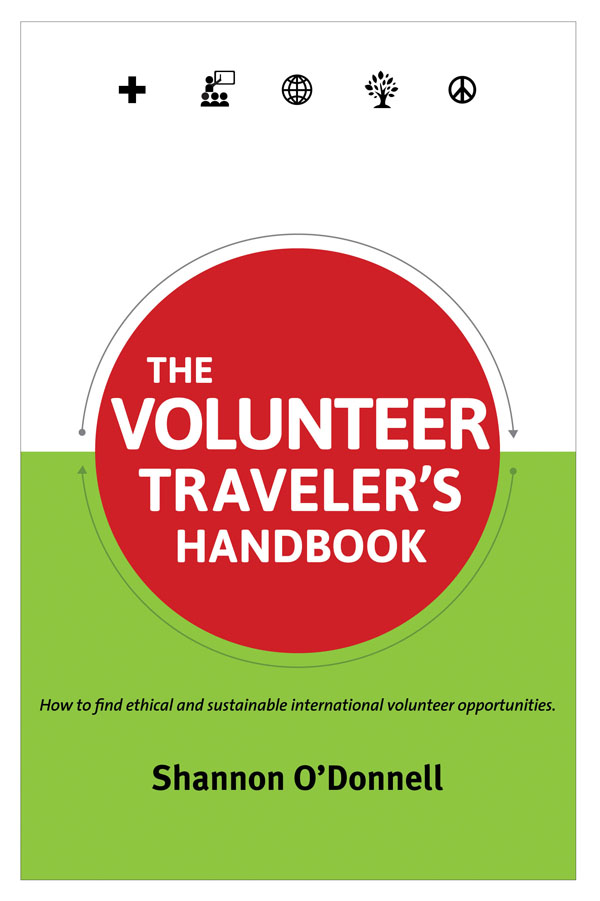Meet Shannon O’Donnell. You may know her as the blogger who talks about travel and volunteering on A Little Adrift. Since 2008, Shannon has been traveling solo and volunteering all over the globe from Mexico to Chiang Mai.

I had a chance to chat with Shannon about her work, her travels and so many other things. Here she explains the best practices to choose a place to volunteer that fits your own needs as well as how-tos for researching. You can buy her book The Volunteer Traveler’s Handbook for more information, including lists of website resources to find places for volunteering.
How would you define in a couple sentences your guidelines for choosing the best volunteer placement?
Choose an organization that resonates with a cause and a situation that resonates with you. Look for a place that is also doing long term sustainable work in a community where you want to work.
What bad experiences have you had and how could they have been avoided?
I volunteered in Nepal and paid placement company to connect me with a monastery. Unfortunately, the company was not straightforward about where the money I paid went. I eventually realized that the monastery where I worked received none of the funds. The monastery was providing me with a place to stay and food, and no one was compensating them for my stay.
The organization that connected me with the monastery did the facilitation and placement. They gave language classes for basic Nepali. They took us around Katmandu. For that reason, the place was good. They weren’t clear, though about where the money I paid them would go. They seemed to feel that providing the monastery with volunteers was enough.
How can people avoid this?
Tough question. It’s harder to do abroad, because it’s easy to say what you want about yourself online. While there are websites that review programs, they don’t review the backend and financials. Many volunteers don’t question where their money is going.
You have to know your own goals. You have to decide what percentage of fees should support the organization. You have to be clear in the ethics of the people who run the organization. After all this research, you have to decide for yourself whether or not it’s good enough for you.
I think if I had e-mailed and asked if they had a long term investment in the future of those children in the monastery and asked more specific questions about financials beforehand. I would have seen more clearly where the fees were going.
It’s much easier to evaluate an organization when you see it in person. Entre Amigos, the community center where I’m currently volunteering in San Pancho, Mexico, is well integrated with the community. You can see what they’re doing and how much the community believes in them.
These days, I rarely go to places where I have to pay. That’s not to say you shouldn’t ever pay. There are many places where it’s worthwhile to pay a fee, particularly if they’re giving you room and board or training.
What are the main issues/problems you find with online research for volunteering?
Glossy branding. It’s easy to think because the branding is good and looks pretty that they have things figured out. We believe that an organizations effectiveness is measured by their logo. Overseas that is not the case. They don’t invest the money and manpower into a website. If a place has a lot of money and has a slick campaign, check to see if it’s run by a western company and what’s their company ethic.
What are the best experiences you had and what lead to them being so good?
The We Women Foundation in Chiang Mai where I volunteered with my niece Ana. We taught English to a Burmese woman I’ll call A who worked at an English institute, A was a refugee from Burma. We Women traditionally works with people who already have a high level of English, and their goal is to help Burmese refugees get into college at high level degrees. A was the house keeper, but she didn’t qualify for the programs. Even though she really wanted to learn English, the organization couldn’t help her until we came along. It was a unique opportunity for her and us. We Women paired us with her, because Ana was there.
What made this so wonderful was having that one on one relationship for an extended period of time. Having Ana there also made it special. I think Ana was impacted in ways that even she hadn’t anticipated. She learned to value her own education in a new way, especially when she saw how hard A worked. Ana doesn’t have to think about the future in the same way. We had a lot of those conversations, many of them initiated by my niece. Ana realizes how lucky she is.
We’ve been able to stay in touch, but not in the way i’ve been able to stay in touch with people who have a higher level of English and access to Facebook. We send hellos and photos to a friend now working at We Women.
Why did you choose to focus on the Miracle Foundation for the book?
The Miracle Foundation is an Austin based non-profit that works to “transform institutional orphanages in India into stable, loving, nurturing homes where children can thrive.” The charity is unique in that their “interventions are measurable, scalable, guard against corruption and focus on the needs of the whole child.”
I found them through Jeff Jung of Career Break Secrets, a website with tips and trips for long term travel. He connected us because he thought she would bring a great perspective to the book, and he was right.
The Miracle Foundation has high end donors supporting the organization’s mission. Once they established their work in India, they began to add in tours but only allow their donors on the tours. These are people who have donated large amounts of money to the organization over a period of time. They have shown that they are truly dedicated to the organization and its mission. All hiring and resources for the tours are done locally and the donors on the tour complete a project for the kids in one orphanage.
What do you think is best in terms of how much money goes to an organization’s mission?
It all depends on what you believe is right and on the mission of the organization. You have to decide for yourself what you want and believe. My personal ethics? I think 80-90% should go back to the organization, but that’s me. I can’t make a blanket statement about what is right for other people.
That’s the point of Grassroots Volunteering. It’s a website in which I’ve complied a list of places to volunteer that I believe to be ethical and sustainable. I have to know at least one person at the organization before I’ll include them in my database. Many people don’t do their own research, though. You have to know your own goals. You have to decide what percentage of fees should support the organization. You have to be clear in the ethics of the people who run the organization. After all this research, you have to decide for yourself whether or not it’s good enough for you.





[…] Interview on Cloudhead.org: Leigh posted this great interview about choosing the best place to volunteer […]